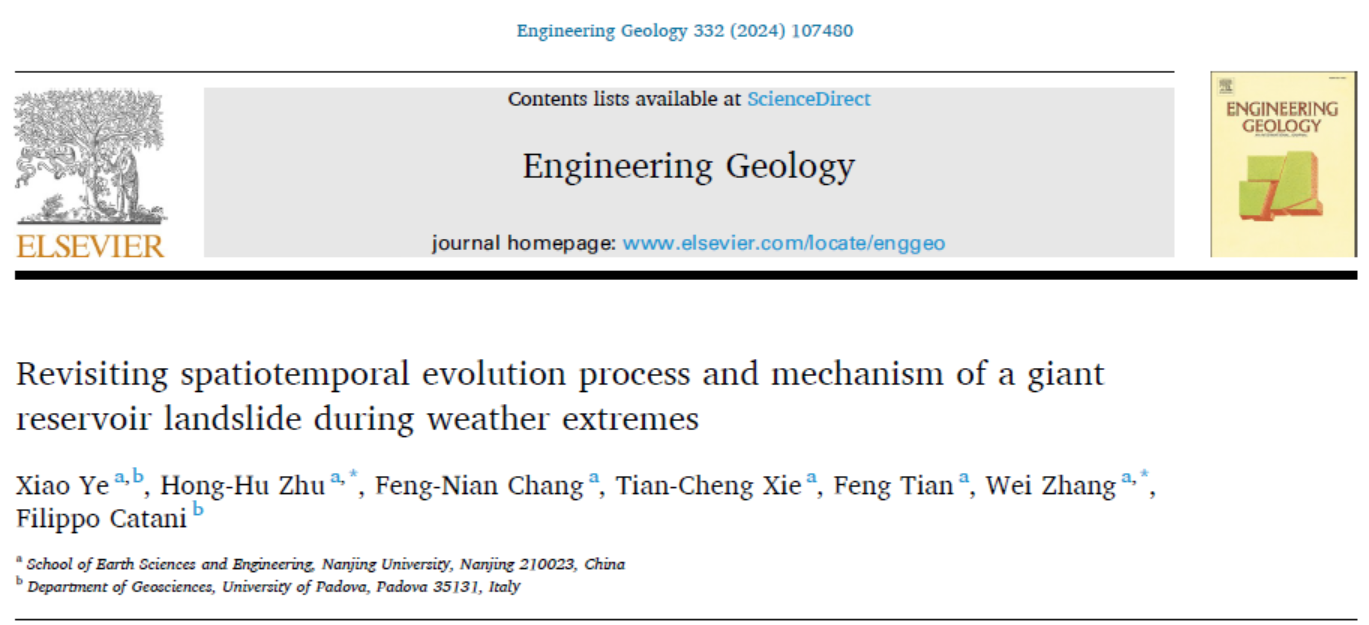 【摘要】
【摘要】
在气候多变和人类活动影响的背景下,深化对滑坡运动学的认识是实现有效风险评估与应急管理的先决条件。本项研究采纳跨学科视角,选取我国三峡库区藕塘滑坡作为案例开展研究。我们分析了2007至2021年间的时空地表活动及时间与子区域依赖的水文气象因素,尤其是识别了触发滑坡活动的降雨模式和库水位。鉴于GNSS地表测点分布的不均衡,我们采用了加权月平均位移和加权测点频次来提升对滑坡活跃子区域分析的精确度。初步成果揭示,七月、九月和六月为滑坡触发的高风险月份,同时也是水位较低的时期。极端天气事件及局部加固措施使得库水位在早期变形控制中的作用逐渐减弱,转而更多地受到降雨的影响。长期地表变形分析显示,滑坡破坏模式向复合模式演变——从主要的牵引式模式转变为以推移为主的模式,甚至包括整体平移与局部旋转的复杂组合。进一步地,通过对标准化位移/应变的比较分析,展示了融合多源监测数据的强大潜能。重新审视藕塘滑坡的演化过程和潜在的变形机制,让我们对库区大型滑坡的动力学有了更深入的理解,并为加强风险管理与应急响应策略指明了方向。

图1 各种滑坡灾害与气候变量之间的关系图(改编自Gariano和Guzzetti,2016)

图2 研究区位置:(a)中国地图,(b)三峡库区数字高程模型(DEM)图,其中红点为典型大型滑坡(即>1×107 m3)和滑坡的位置,(c) 2021年5月无人机摄影测量得到的瓯塘滑坡DEM图。黄色曲线表示滑坡边界,(d)三峡库区水位变化曲线及藕塘滑坡多源监测数据的采集范围。该水库于2003年开始蓄水,自2010年以来,每年库水位在145至175m之间波动
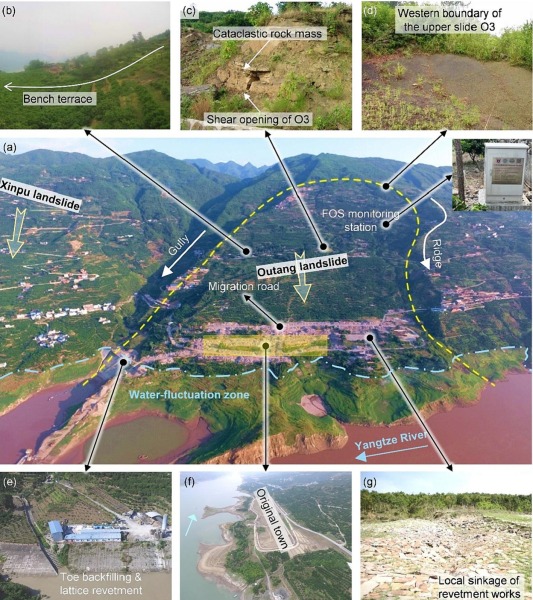
图3 藕塘滑坡工程地质及地貌照片:(a)滑坡全景图,拍摄于2018年6月。消落带在雨季暴露在空气中,但在雨季结束后逐渐被河流淹没,(b-d)滑坡前缘台地、近水平剪切开口、滑坡上部(O3)尾缘边界,(e-g)滑坡下部(O1)宏观变形及对策。2013年,针对滑坡下部变形强度区(即后文讨论的WDZ和EDZ),实施了必要的应急工程措施,包括砌体护岸、回填趾重、格栅护岸、截流沟等
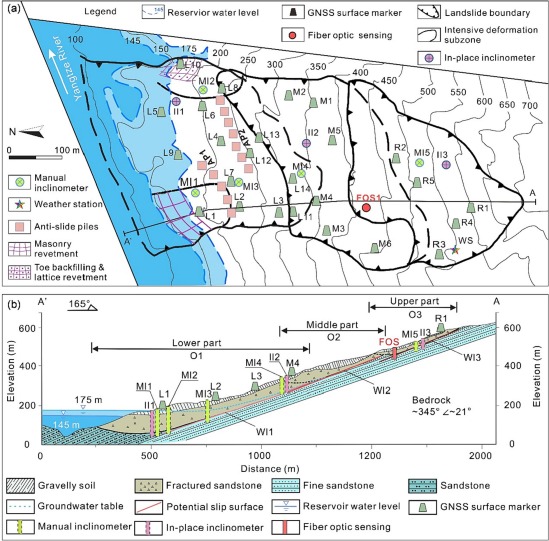
图4 藕塘滑坡地质背景及长期监测工作:(a)利用GNSS、测斜仪及光纤传感等岩土工程监测技术对滑坡进行平面观察,并在2002年实施抗滑桩AP1、AP2,2013年实施O1区砌体护岸、回填趾重、点阵护岸等工程对策,(b)图4a中沿剖面线A-A′的截面,其中显示了手动测斜仪和原位测斜仪的位置

图5 藕塘滑坡的三个主要滑动面(改编自Dai et al.,2016)
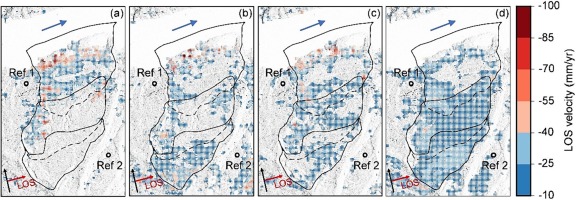
图6 2007年1月- 2010年12月ALOS/PALSAR-1遥感数据反演研究区LOS位移速度图。(a)2007/01/30-2008/02/02,(b) 2008/02/02-2009/02/04,(c) 2009/02/04-2010/01/15,(d) 2010/01/15-2010/12/26。从每个子图中减去局部参考点(Ref 1和Ref 2)的平均速度值,以减轻空间相干噪声并强调相对运动。为了清晰起见,将速度值裁剪为(- 100,- 10)
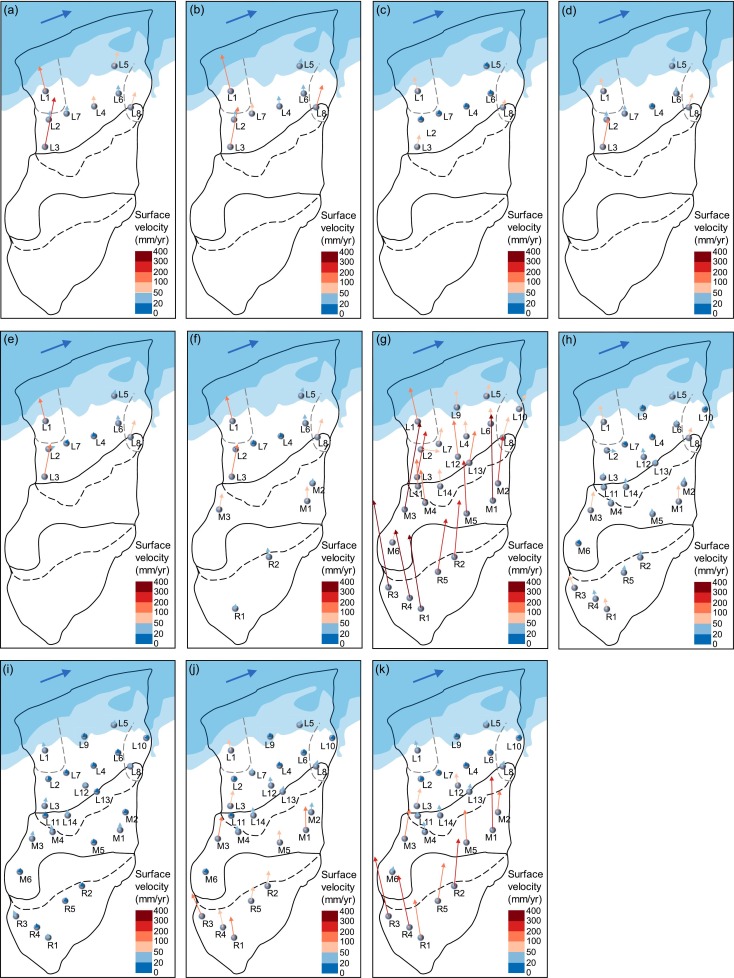
图7 藕塘滑坡年平均位移速率图:(a-k)分别从2011年1月至2021年12月从GNSS基准中获取的横向位移速度
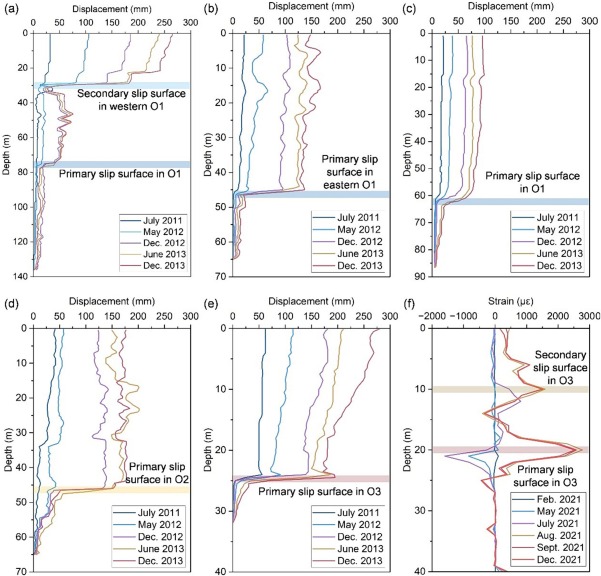
图8 测斜仪和光纤应变传感神经获得的局部变形区深部变形(见图4a):(a-e)分别由MI1、MI2、MI3、MI4和MI5测量的水平向位移(Luo和Huang, 2020),其中MI1和MI2分别位于01期西部(WDZ)和东部(EDZ)局部形变强烈带,MI3、MI4和MI5分别沿接近直线的剖面线、位于滑坡的O1、O2和O3区。自2014年以来,几个测斜仪由于严重变形,无法正常工作。(f)安装在钻孔FOS中的应变传感神经显示的应变曲线(改编自Ye et al., 2022)

图9 位于滑坡三个区的原位测斜仪测得的深部变形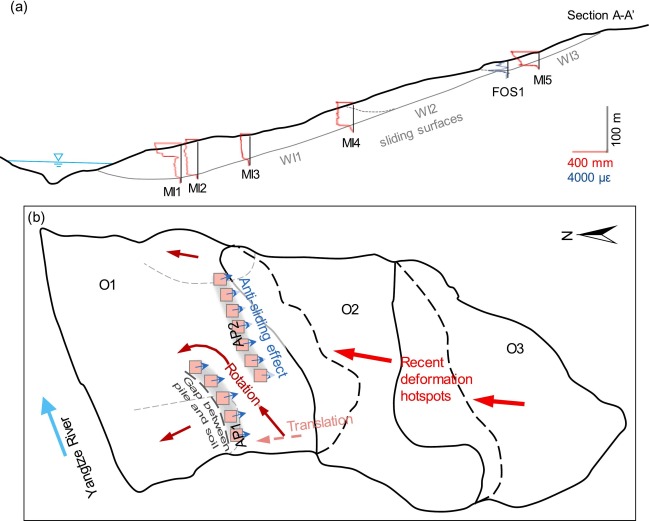
图10 藕塘滑坡的地表和地下运动学图解:(a)测斜仪测得的位移和光纤传感神经测得的应变分布曲线,(b) 抗滑桩对滑坡变形过程的影响
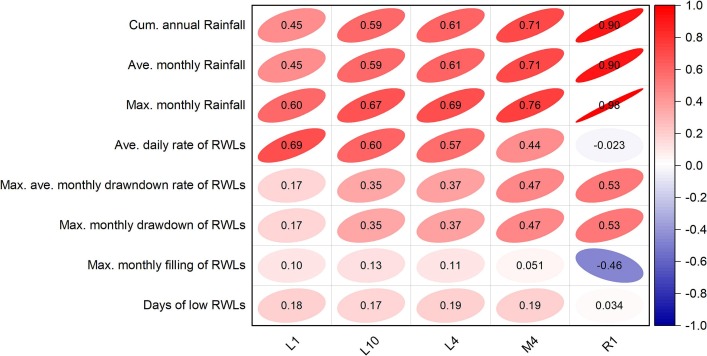
图11 相关系数映射图。2011年至2021年三个子区内代表性GNSS的历史年位移与水文气象变量之间的Pearson相关系数
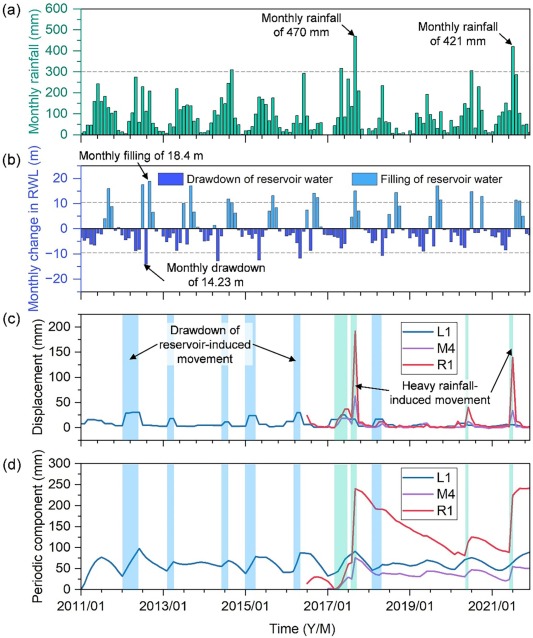
图12 滑坡三个亚带内加速变形的驱动因素:(a)月降雨量,(b)库水位月变化曲线,(c) GNSS测点L1、M4和R1的的历史月位移曲线,(d) GNSS测点L1、M4、R1的累积位移中的周期项。浅蓝色和浅绿色条纹分别表示库水位和降雨量下降导致的加速变形
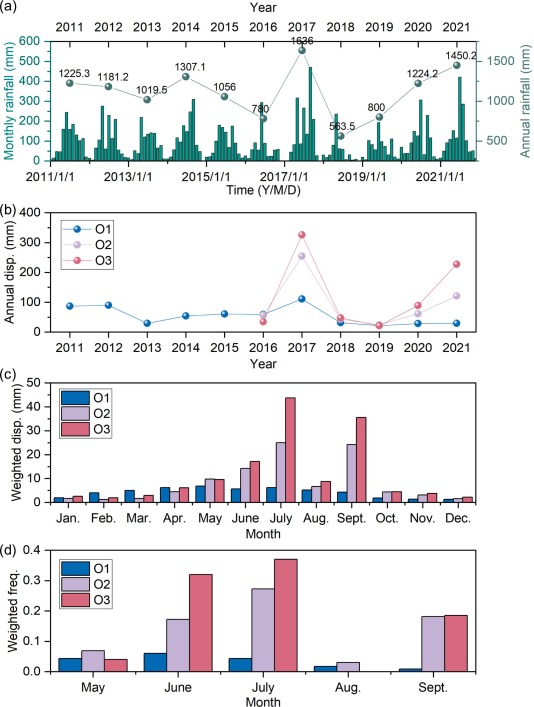
图13 滑坡各部位与降雨的关系:(a)月和年降雨量,(b)下部(O1)、中部(O2)和上部(O3)年平均位移时间序列,(c)每个部位的加权平均月位移的分布统计,(d)汛期GNSS地表位移≥30 mm/月的加权频率
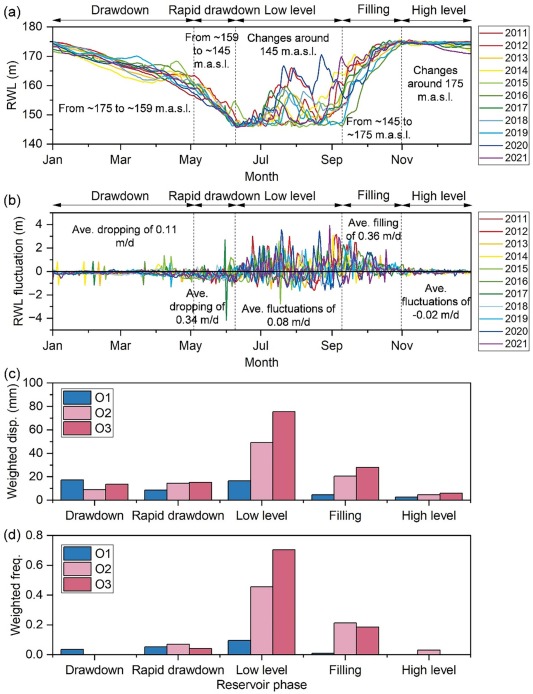
图14 各部位滑坡活动与水库位的关系:(a)和(b)库水位及其波动的历史年度记录,(c)在库水位波动下每个部位的加权平均位移量,(d) 5个库水位事件中GNSS地表位移≥30 mm的加权频率
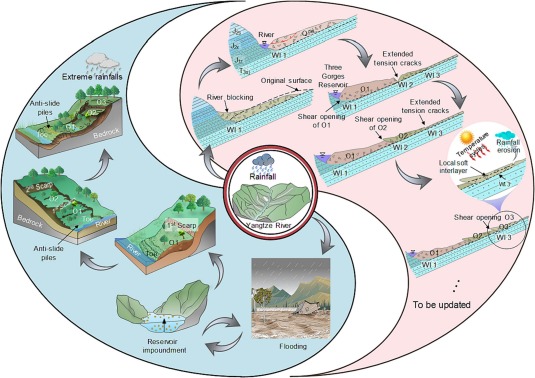
图15 从地表动力学(左侧)和破坏机制(右侧)两方面分析大型水库滑坡在不同时空尺度上的地貌变迁和递进破坏过程
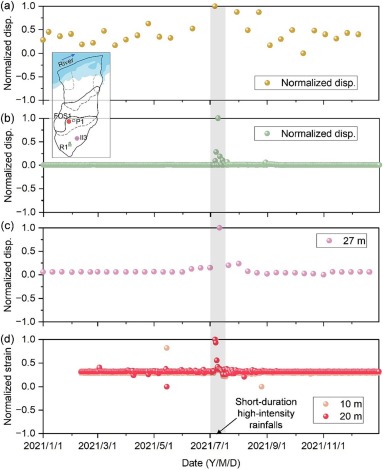
图16 使用不同监测技术对某个监测位置的归一化滑坡变形(即地表和地下位移/应变)进行比较分析:(a) InSAR(即从P1检索),(b) GNSS(即从R1收集的数据),(c)安装在II3的、27 m深的原位测斜仪,(d) FOS1钻孔中10m和20m深处滑动面附近的光纤应变值
【结论】
为了阐明水库运行对巨型滑坡演化过程和变形特征的影响,本项工作选取了藕塘滑坡作为案例研究,自2007年起收集了多源监测数据,以绘制该滑坡的时空演变过程。在此基础上,我们试图解答有关降雨量以及哪些月份更易引发滑坡活动的问题。鉴于GNSS地表位移测点在滑坡各个子区的分布不均,我们定义了加权月平均位移和加权测点频率以量化子区域的活跃度。多年尺度的年度速率图展示了这一古滑坡的复活和阶梯式加速。初步结果表明,七月、九月和六月是滑坡最为敏感的三个月份,也是全年中水位相对较低的时段。随着抗滑桩加固措施的实施,以前库水位对滑坡下部的主导作用逐渐减弱,而中、上部则逐步被激活,且几乎完全受到降雨影响。在极端湿润年份,例如月降雨量超过400毫米或年降雨量超过1200毫米时,滑坡活动的可能性显著增加。
藕塘滑坡的渐进式破坏过程和子区域依赖的变形驱动因素反映了三峡库区许多巨型滑坡的行为模式。随着不稳定体块的扩展,滑坡的破坏模式从典型的牵引式演化为主要以推移式为特征的复合型。此外,抗滑桩的设置也使得变形机制变得更加复杂,滑坡由全局性向下滑动转变为局部旋转变形。此项工作进一步指出,变形的主要驱动因素正在发生显著的转变。库水位的影响似乎正在逐渐减弱,而在极端天气情境下,降雨的作用变得越来越明显。这部分原因可归因于以往水库控制的滑坡变形机制受到了紧急滑坡加固措施的制约。
解读此类巨型水库滑坡的动力过程和机制并非毫无挑战。我们呼吁采取跨学科合作研究和多源数据融合方法来缓解未知因素或争议。这种协同方法不仅可提升滑坡风险评估的精确性,也有助于制定更有效的监测策略和应急管理措施。
Revisiting spatiotemporal evolution process and mechanism of a giant reservoir landslide during weather extremes
【Abstract】
An updated comprehension of landslide kinematics is a prerequisite for developing effective risk assessment and emergency management in the context of climate variability and anthropogenic disturbances. This study employs a multidisciplinary approach, taking the Outang landslide in China’s Three Gorges Reservoir area as a case study. We examined the spatiotemporal surface processes and time- and subzone-dependent hydrometeorological factors from 2007 to 2021, particularly identifying rainfall regimes and reservoir water levels that trigger landslide movements. Given the uneven distribution of GNSS surface markers, we introduced weighted monthly mean displacement (D) and weighted marker frequency (f), enhancing the accuracy of our insights into distinct active subzones of the landslide. Preliminary results revealed July, September and June as months of higher susceptibility, as well as months with low water levels. The early-stage deformation control by reservoir water levels is being increasingly overshadowed by rainfall, due to extreme weather events and localized anti-slip measures. Long-term surface processes have also highlighted the transformation of landslide failure modes towards a compound pattern, from a predominantly retrogressive to a thrust-dominated pattern, and even overall translation coupled with localized rotation. Furthermore, the comparative analysis of normalized displacement/strain demonstrates the power and potential of integrating multi-source monitoring data. By revisiting the evolution processes and potential deformation mechanisms of the Outang landslide, we are getting closer to understanding more about the dynamics of giant landslides in reservoir areas, and illuminate the pathway towards enhanced risk management and emergency response strategies.
【Keywords】 Slow-moving landslide; Earth surface process; Geotechnical monitoring; Extreme weather; Uncertainty; Emergency management
【参考文献】
Alonso, E.E., Zervos, A., Pinyol, N.M., 2016. Thermo-poro-mechanical analysis of landslides: from creeping behaviour to catastrophic failure. Géotechnique 66(3), 202-219. http://dx.doi.org/10.1680/jgeot.15.LM.006
Biggs, J., Wright, T.J., 2020. How satellite InSAR has grown from opportunistic science to routine monitoring over the last decade. Nat. Commun. 11, 3863. https://doi.org/10.1038/s41467-020-17587-6
Chang, F.N., Dong, S.C., Yin, H.W., Wu, Z.Y., 2022. Using the SBAS InSAR technique to monitor surface deformation in the Kuqa fold-thrust belt, Tarim Basin, NW China. J. Asian Earth Sci. 231, 105212. https://doi.org/10.1016/j.jseaes.2022.105212
Chang, F.N., Dong, S.C., Yin, H.W., Ye, X., Zhang, W., Zhu, H.H., 2024.Temporal stacking of sub-pixel offset tracking for monitoring slow-moving landslides in vegetated terrain. Landslides (in press).
Cohen-Waeber, J., Bürgmann, R., Chaussard, E., Giannico, C., Ferretti, A., 2018. Spatiotemporal patterns of precipitation-modulated landslide deformation from independent component analysis of InSAR time series. Geophys. Res. Lett. 45, 1878-1887. https://doi.org/10.1002/2017GL075950
Costantini, M., 1998. A novel phase unwrapping method based on network programming. IEEE Trans. Geosci. Electron. 36(3), 813-821. https://doi.org/10.1109/36.673674
Dai, Z.W., Yin, Y.P., Wei, Y.J., Lv, T., Luo, J.H., Yao, W., 2016. Deformation and failure mechanism of Outang Landslide in Three Gorges Reservoir area. J. Eng. Geol. 24(1), 44-55. https://doi.org/10.13544/j.cnki.jeg.2016.01.006 (in Chinese)
Dai, Z.W., Zhang, Y.J., Zhang, C.Y., Luo, J.H., Yao, W., 2022. Interpreting the influence of reservoir water level fluctuation on the seepage and stability of an ancient landslide in the Three Gorges Reservoir area: a case study of the Outang landslide. Geotech. Geol. Eng. 40, 4551-4561. https://doi.org/10.1007/s10706-022-02170-1
De Luca, P., Messori, G., Wilby, R. L., Mazzoleni, M., Di Baldassarre, G., 2020. Concurrent wet and dry hydrological extremes at the global scale. Earth Syst. Dynam. 11, 251-266. https://doi.org/10.5194/esd-11-251-2020
Du, J., Yin, K.L., Lacasse, S., 2013. Displacement prediction in colluvial landslides, three Gorges reservoir, China. Landslides 10(2), 203-218. https://doi.org/10.1007/s10346-012-0326-8
Fan, L.F., Lehmann, P., Zheng, C.M., Or, D., 2020. Rainfall intensity temporal patterns affect shallow landslide triggering and hazard evolution. Geophys. Res. Lett. 47, e2019GL085994. https://doi.org/10.1029/2019GL085994
Fang, K., Zhang, J.F., Tang, H.M., Hu, X.L., Yuan, H.H., Wang, X.T., An, P.J., Ding, B.D., 2023. A quick and low-cost smartphone photogrammetry method for obtaining 3D particle size and shape. Eng. Geol. 322, 107170. https://doi.org/10.1016/j.enggeo.2023.107170
Ferrari, A., Ledesma, A., González, D.A., Corominas, J., 2011. Effects of the foot evolution on the behaviour of slow-moving landslides. Eng. Geol. 117, 217-218. https://doi.org/10.1016/j.enggeo.2010.11.001
Finnegan, N.J., Perkins, J.P., Nereson, A.L., Handwerger, A.L., 2021. Unsaturated flow processes and the onset of seasonal deformation in slow-moving landslides. J. Geophys. Res. Earth Surf. 126, e2020JF005758. https://doi.org/10.1029/2020JF005758
Gariano, S.L., Guzzetti, F., 2016. Landslides in a changing climate. Earth-Sci. Rev.162, 227-252. https://doi.org/10.1016/j.earscirev.2016.08.011
Gili, J.A., Corominas, J., Rius, J., 2000. Using global positioning system techniques in landslide monitoring. Eng. Geol. 55(3), 167-192. https://doi.org/10.1016/S0013-7952(99)00127-1
Gong, W.P., Zhao, C., Zhuang, C.H., Tang, H.M., Wang, H., Hu, X.L., 2020. Stratigraphic uncertainty modelling with random field approach. Comput. Geotech. 125, 103681. https://doi.org/10.1016/j.compgeo.2020.103681
Guo, J.Y., Shi, B., Sun, M.Y., Zhang, C.C., Tang, C. S., Wei, G.Q., Fang, J.H., Jiang, H.T., 2023. Soil total suction sensing using fiber-optic technology. Geoderma 439, 116687. https://doi.org/10.1016/j.geoderma.2023.116687
Huang, X.H., Guo, F., Deng, M.L., Yi, W., Huang, H.F., 2020. Understanding the deformation mechanism and threshold reservoir level of the floating weight-reducing landslide in the Three Gorges Reservoir Area, China. Landslides 17, 2879-2894. https://doi.org/10.1007/s10346-020-01435-1
Hugentobler, M., Loew, S., Aaron, J., Roques, C., Oestreicher, N., 2020. Borehole monitoring of thermo-hydro-mechanical rock slope processes adjacent to an actively retreating glacier. Geomorphology 362, 107190. https://doi.org/10.1016/j.geomorph.2020.107190
Hungr, O., Leroueil, S., Picarelli, L., 2014. The Varnes classification of landslide types, an update. Landslides 11, 167-194. https://doi.org/10.1007/s10346-013-0436-y
Iqbal, J., Tu, X.B., Xu, L., 2017. Landslide hazards in reservoir areas: Case study of Xiangjiaba Reservoir, Southwest China. Nat. Hazards Rev. 18(4), 04017009. https://doi.org/10.1061/(ASCE)NH.1527-6996.0000245
Jones, J.N., Boulton, S.J., Bennett, G.L., Stokes, M., Whitworth, M.R.Z., 2021. Temporal variations in landslide distributions following extreme events: Implications for landslide susceptibility modeling. J. Geophys. Res. Earth Surf. 126, e2021JF006067. https://doi.org/10.1029/2021JF006067
Kafle, L., Xu, W.J., Zeng, S.Y., Nagel, T., 2022. A numerical investigation of slope stability influenced by the combined effects of reservoir water level fluctuations and precipitation: A case study of the Bianjiazhai landslide in China. Eng. Geol. 297, 106508. https://doi.org/10.1016/j.enggeo.2021.106508
Kogure, T., Okuda, Y., 2018. Monitoring the vertical distribution of rainfall-induced strain changes in a landslide measured by distributed fibre optic sensing with Rayleigh backscattering. Geophys. Res. Lett. 45(9), 4033-4040. https://doi.org/10.1029/2018GL077607
Lacroix, P., Handwerger, A. L., & Bièvre, G. (2020). Life and death of slow-moving landslides. Nat. Rev. Earth Environ. 1(8), 404-419. https://doi.org/10.1038/s43017-020-0072-8
Lehmann, P., Or, D., 2012. Hydromechanical triggering of landslides: From progressive local failures to mass release. Water Resour. Res. 48, W03535. https://doi.org/10.1029/2011WR010947
Li, Y., Utili, S., Milledge, D., Chen, L.X., Yin, K.L., 2021. Chasing a complete understanding of the failure mechanisms and potential hazards of the slow moving Liangshuijing landslide. Eng. Geol. 281, 105977. https://doi.org/10.1016/j.enggeo.2020.105977
Luo, S.L., Jin, X.G., Huang, D., 2019. Long-term coupled effects of hydrological factors on kinematic responses of a reactivated landslide in the Three Gorges Reservoir. Eng. Geol. 261, 105271. https://doi.org/10.1016/j.enggeo.2019.105271
Luo, S.L., Huang, D., 2020. Deformation characteristics and reactivation mechanisms of the Outang ancient landslide in the Three Gorges Reservoir, China. Bull. Eng. Geol. Environ. 79, 3943-3958. https://doi.org/10.1007/s10064-020-01838-3
Mondini, A.C., Guzzetti, F., Melillo, M., 2023. Deep learning forecast of rainfall-induced shallow landslides. Nat. Commun. 14, 2466. https://doi.org/10.1038/s41467-023-38135-y
Nava, L., Carraro, E., Reyes-Carmona, C., Puliero, S., Bhuyan, K., Rosi, A., Monserrat, O., Floris, M., Meena, S.R., Galve, J.P., Catani, F., 2023. Landslide displacement forecasting using deep learning and monitoring data across selected sites. Landslides 20, 2111-2129. https://doi.org/10.1007/s10346-023-02104-9
Ozturk, U., Bozzolan, E., Holcombe, E.A., Shukla, R., Pianosi, F., Wagener, T., 2022. How climate change and unplanned urban sprawl bring more landslides. Nature 608, 262-265. https://doi.org/10.1038/d41586-022-02141-9
Palmer, J., 2017. Creeping earth could hold secret to deadly landslides. Nature 548, 384-386. https://doi.org/10.1038/548384a
Paronuzzi, P., Rigo, E., Bolla, A., 2013. Influence of filling-drawdown cycles of the Vajont reservoir on Mt. Toc slope stability. Geomorphology 191(1-2), 75-93. https://doi.org/10.1016/j.geomorph.2013.03.004
Schenato, L., Palmieri, L., Camporese, M., Bersan, S., Cola, S., Pasuto, A., Galtarossa, A., Salandin, P., Simonini, P., 2017. Distributed optical fibre sensing for early detection of shallow landslides triggering. Sci. Rep. 7, 14686. https://doi.org/10.1038/s41598-017-12610-1
Schulz, W.H., Smith, J.B., Wang, G., Jiang, Y., Roering, J.J., 2018. Clayey landslide initiation and acceleration strongly modulated by soil swelling. Geophys. Res. Lett. 45(4), 1888-1896. https://doi.org/10.1002/2017GL076807
Schuster, R.L., 1979. Reservoir-induced landslides. Bull. Int. Assoc. Eng. Geol. 20, 8-15. https://doi.org/10.1007/BF02591233
Shi, B., Zhang, D., Zhu, H.H., Zhang, C.C., Gu, K., Sang, H.W., Han, H.M., Sun, M.Y., Liu, J., 2021. DFOS applications to geo-engineering monitoring. Photonic Sens. 11, 158-186. https://doi.org/10.1007/s13320-021-0620-y
Sim, K.B., Lee, M.L., Wong, S.Y., 2022. A review of landslide acceptable risk and tolerable risk. Geoenviron Disasters 9(3), 17. https://doi.org/10.1186/s40677-022-00205-6
Strozzi, T., Delaloye, R., Kääb, A., Ambrosi, C., Perruchoud, E., Wegmüller, U., 2010. Combined observations of rock mass movements using satellite SAR interferometry, differential GPS, airborne digital photogrammetry, and airborne photography interpretation. J. Geophys. Res. Earth Surf. 115, F01014. https://doi.org/10.1029/2009JF001311
Stumvoll, M.J., Schmaltz, E.M., Kanta, R., Roth, H., Grall, B., Luhn, J., Flores-Orozco, A., Glade, T., 2022. Exploring the dynamics of a complex, slow-moving landslide in the Austrian Flysch Zone with 4D surface and subsurface information. Catena 214, 106203. https://doi.org/10.1016/j.catena.2022.106203
Tang, H.M., Wasowski, J., Juang, C.H., 2019a. Geohazards in the Three Gorges Reservoir area, China-Lessons learned from decades of research. Eng. Geol. 261, 105267. https://doi.org/10.1016/j.enggeo.2019.105267
Tang, M.G., Xu, Q., Li, Y.S., Huang, R.Q., Rengers, N., Zhu, X., 2016. Partial reactivation of a huge deep-seated ancient rock slide: recognition, formation mechanism, and stability. Nat. Hazards Earth Syst. Sci. 16(8), 1719-1735. https://doi.org/10.5194/nhess-16-1719-2016
Tang, M.G., Xu, Q., Yang, H., Li, S.L., Iqbal, J., Fu, X.L., Huang, X.B., Cheng, W.M., 2019b. Activity law and hydraulics mechanism of landslides with different sliding surface and permeability in the Three Gorges Reservoir Area, China. Eng. Geol. 260, 105212. https://doi.org/10.1016/j.enggeo.2019.105212
Tichavský, R., Ballesteros-Cánovas, J.A., Šilhán, K., Tolasz, R., Stoffel, M., 2019. Dry spells and extreme precipitation are the main trigger of landslides in Central Europe. Sci. Rep. 9, 14560. https://doi.org/10.1038/s41598-019-51148-2
Torres, M.E., Colominas, M.A., Schlotthauer, G., Flandrinet, P., 2011. A complete ensemble empirical mode decomposition with adaptive noise. 2011 IEEE International Conference on Acoustics, Speech and Signal Processing (ICASSP), Prague, Czech Republic, 2011, pp. 4144-4147. https://doi.org/10.1109/ICASSP.2011.5947265
Westra, S., Fowler, H.J., Evans, J.P., Alexander, L.V., Berg, P., Johnson, F., Kendon, E.J., Lenderink, G., Roberts, N.M., 2014. Future changes to the intensity and frequency of short-duration extreme rainfall. Rev. Geophys. 52, 522-555. https://doi.org/10.1002/2014RG000464
Yang, B.B., Yin, K.L., Lacasse, S., Liu, Z.Q., 2019. Time series analysis and long short-term memory neural network to predict landslide displacement. Landslides 16, 677-694. https://doi.org/10.1007/s10346-018-01127-x
Yan, Y., Tang, H., Hu, K.H., Turowski, J.M., Wei, F.Q., 2023. Deriving debris-flow dynamics from real-time impact-force measurements. J. Geophys. Res. Earth Surf. 128, e2022JF006715. https://doi.org/10.1029/2022JF006715
Yao, W.M., Li, C.D., Guo, Y.C., Criss, R.E., Zuo, Q.J., Zhan, H.B., 2022. Short‑term deformation characteristics, displacement prediction, and kinematic mechanism of Baijiabao landslide based on updated monitoring data. Bull. Eng. Geol. Environ. 81, 393. https://doi.org/10.1007/s10064-022-02912-8
Ye, X., Zhu, H. H., Cheng, G., Pei, H. F., Shi, B., Schenato, L., Pasuto, A., 2024. Thermo-hydro-poro-mechanical responses of a reservoir-induced landslide tracked by high-resolution fiber optic sensing nerves. J. Rock Mech. Geotech. Eng. https://doi.org/10.1016/j.jrmge.2023.04.004 (in press)
Ye, X., Zhu, H.H., Wang, J., Zhang, Q., Shi, B., Schenato, L., Pasuto, A, 2022. Subsurface multi-physical monitoring of a reservoir landslide with the fiber-optic nerve system. Geophys. Res. Lett. 49(11), e2022GL098211. https://doi.org/10.1029/2022GL098211
Yin, Y.M., Deng, Q.L., Li, W.B., He, K., Wang, Z.H., Li, H.J., An, P.J., Fang, K., 2023. Insight into the crack characteristics and mechanisms of retrogressive slope failures: A large-scale model test. Eng. Geol. 327, 107360. https://doi.org/10.1016/j.enggeo.2023.107360
Yin, Y.P., Huang, B.L., Wang, W.P., Wei, Y.J., Ma, X.H., Ma, F., Zhao, C., 2016. Reservoir-induced landslides and risk control in three Gorges Project on Yangtze River, China. J. Rock Mech. Geotech. Eng. 8, 577-595. http://dx.doi.org/10.1016/j.jrmge.2016.08.001
Zeng, T.R., Glade, T., Xie, Y.Y., Yin, K.L., Peduto, D., 2023a. Deep learning powered long-term warning systems for reservoir landslides. Int. J. Disast. Risk Re. 94, 103820. https://doi.org/10.1016/j.ijdrr.2023.103820
Zeng T.R., Yin K.L., Gui L., Peduto D., Wu L.Y., Guo Z.Z., Li Y., 2023b. Quantitative risk assessment of the Shilongmen reservoir landslide in the Three Gorges area of China. Bull. Eng. Geol. Environ. 82, 214. https://doi.org/10.1007/s10064-023-03242-z
Zeng T.R., Yin K.L., Jiang H.W., Liu X.P., Guo Z.Z., Peduto D., 2022. Groundwater level prediction based on a combined intelligence method for the Sifangbei landslide in the Three Gorges Reservoir Area. Sci. Rep. 12, 11108. https://doi.org/10.1038/s41598-022-14037-9
Zhang, C.Y., Yin, Y.P., Yan, H., Li, H.X., Dai, Z.W., Zhang, N., 2021. Reactivation characteristics and hydrological inducing factors of a massive ancient landslide in the three Gorges Reservoir, China. Eng. Geol. 292, 106273. https://doi.org/10.1016/j.enggeo.2021.106273
Zhang, J.R, Tang, H.M., Li, C.D., Gong, W.P., Zhou, B.Y., Zhang, Y.Q., 2024a. Deformation stage division and early warning of landslides based on the statistical characteristics of landslide kinematic features. Landslides. https://doi.org/10.1007/s10346-023-02192-7
Zhang, L., Cui, Y.F., Zhu, H.H., Wu, H., Han, H.M., Yan, Y., Shi, B., 2023. Shear deformation calculation of landslide using distributed strain sensing technology considering the coupling effect. Landslides 20, 1583-1597. https://doi.org/10.1007/s10346-023-02051-5
Zhang, L., Zhu, H.H., Han, H.M., Shi, B., 2024b. Fiber optic monitoring of an anti-slide pile in a retrogressive landslide. J. Rock Mech. Geotech. Eng. 16(1), 333-343. https://doi.org/10.1016/j.jrmge.2023.02.011
Zheng, W.J., Hu, J., Lu, Z., Hu, X., Sun, Q., Liu, J.H., Zhu, J.J., Li, Z.W., 2023. Enhanced kinematic inversion of 3-D displacements, geometry, and hydraulic properties of a North-South slow-moving landslide in Three Gorges Reservoir. J. Geophys. Res. Solid Earth. 128(6), e2022JB026232. https://doi.org/10.1029/2022JB026232
Zhou, C., Cao, Y., Hu, X., Yin, K.L., Wang, Y., Catani, F., 2022a. Enhanced dynamic landslide hazard mapping using MT-InSAR method in the Three Gorges Reservoir Area. Landslides 19, 1585-1597. https://doi.org/10.1007/s10346-021-01796-1
Zhou, C., Cao, Y., Yin, K.L., Intrieri, E., Catani, F., Wu, L.X., 2022b. Characteristic comparison of seepage-driven and buoyancy-driven landslides in Three Gorges Reservoir area, China. Eng. Geol. 301, 106590. https://doi.org/10.1016/j.enggeo.2022.106590
Zhu, H.H., Ye, X., Pei, H.F., Zhang, W., Cheng, G., Li, Z.L., 2024. Probing multi-physical process and deformation mechanism of a large-scale landslide using integrated dual-source monitoring. Geosci. Front. 15(2), 101773. https://doi.org/10.1016/j.gsf.2023.101773
Zscheischler, J., Westra, S., Van Den Hurk, B.J.J.M., Seneviratne, S.I., Ward, P.J., Pitman, A., AghaKouchak, A., Bresch, D.N., Leonard, M., Wahl, T., Zhang, X.B., 2018. Future climate risk from compound events. Nat. Clim. Change 8(6), 469-477. https://doi.org/10.1038/s41558-018-0156-3
